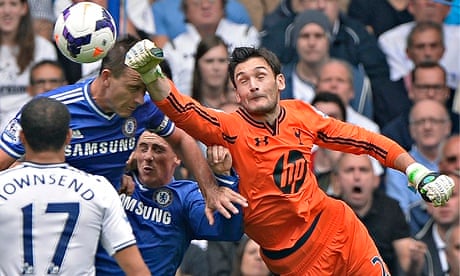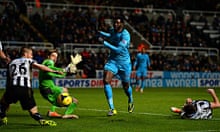There was a moment during the first half of Tottenham Hotspur's 1-0 win over Everton on Sunday when Steven Pienaar, drifting in from the left, sought out the run of Kevin Mirallas, cutting in from the right. He played what probably seemed a well-weighted through ball, only for a flash of orange to materialise to stifle the danger almost before it had gestated. The moment went largely unnoticed, particularly by comparison with the diving save he made from Leon Osman's early drive, but this was Hugo Lloris at his best.
When things began to go awry under André Villas-Boas, Lloris's confidence seemed to be as badly hit as anybody's. His mistake in the first minute away to Manchester City, gifting a goal to Jesús Navas, was arguably the moment at which the Villas-Boas regime imploded. Even on Sunday, there was one ill-judged pass to Michael Dawson that led to an Everton chance, but generally his form appears slowly to be returning.
That's the problem with goalkeeping in general and Lloris's way of playing in particular – hours of competence can be undermined by one slip and much of what is best goes unremarked upon. Peter Shilton claimed that in some of his best games for Nottingham Forest he hardly touched the ball but he knew he was shutting off attacks at source with his positioning and his organisation of the defence. Although Lloris can pull off the spectacular, his key skill is arguably leaving his line quickly to mop up behind the defence – or, even more significantly, being known to be quick off his line and so dissuading opponents from trying to slide passes behind the defence; which when one of your central defenders is as slow in the turn as Dawson, is a huge advantage.
Dawson's lack of pace, presumably, was why Villas-Boas initially wanted to sell him as he tried to impose his high line – and also why he signed Lloris in the first place. The goal Spurs conceded at home to Newcastle this season was in part the result of the lack of pace off his line of Brad Friedel, deputising for Lloris, who had been concussed at Everton.
Opta's statistics (not including the midweek fixtures) show clearly where Lloris's strength lies. Although he has saved only 67.31% of shots hit at him this season, which ranks him 23rd of the 34 goalkeepers to have played in the Premier League this season, he has successfully swept up behind his defence 33 times, more than anybody apart from Newcastle's Tim Krul (39).
When Lloris arrived from Lyon in the summer of 2012 he quickly became aware that he played differently to the majority of Premier League keepers. "In England there is a lot of contact in the box, a lot of quality crosses," he said. "A lot of presence too. Here, the keeper is less protected than in France or in European competitions. It is important to know to fight, notably on corners. I have always heard I am not strong enough, I didn't have the right body for that league. That is no trouble to me, as long as you know your body and your qualities and drawbacks.
"Since I have been in England I didn't rush into bodybuilding. I have gone on working as I did in France but adapting to the different approach of the keeper's position. I always had a risky game. I have always tried to control my box and even a bit further away. I want to be the boss of the area, then, sometimes you get success, sometimes not."
As such, Lloris stands as the modern exponent of a strand of goalkeeping stretching back into the great Hungarian Gyula Grosics. After the Football Association restricted goalkeepers to handling in their own box (as opposed to their own half) in 1912, goalkeepers tended to hang back, coming off their lines to narrow the angle but little more. Grosics, the keeper when Hungary beat England 6-3 at Wembley in 1953, began to change that – at one point in that game, he kicks a ball clear right on the 18-yard line, something that drew gasps of astonishment from the commentator Kenneth Wolstenholme.
Apostol Sokolov, Lev Yashin and Amadeo Carrizo took the notion further, while in England the first real exponent of the sweeper-keeper's art was Liverpool's Tommy Lawrence. Nicknamed the Flying Pig for the way he would charge from his line, his willingness to act as an additional defender allowed Liverpool to play with what was, for the time, an aggressively high offside line. It was the Ajax of Rinus Michels who took the concept to its extremes, though, their hard pressing demanding a goalkeeper who could fill the space behind the defensive line. "If everybody moves forward," Johan Cruyff explained, "you need an extra defender, so the goalkeeper has to be able to play as well."
They found the ideal man in Heinz Stuy, the keeper for each of their three European Cup wins between 1971 and 1973. His ability to sweep behind the back four kept him in the side, despite a habit of dropping crosses as though they were a croquette that had just emerged from a deep fat fryer – earning him the nickname Heinz Kroket. As a coach, Cruyff remained adamant his goalkeeper had to be prepared to leave his line, to take risks. "You have to learn that the great fear of goalkeepers that they will be beaten by a ball lobbed over their head from the halfway line is not based in reality," he said. "If he plays like that, in the interests of the team, then it doesn't matter … if once in a while he doesn't save a high ball." [There is far more on this and other theories of goalkeeping in The Outsider.]
The likes of Edwin van der Sar and Víctor Valdés have taken the theory even further, functioning, as Cruyff demanded, not merely as a defender but at times almost as a playmaker. Lloris does not do that – just as well, given his pass completion rate this season is only 42.5% – but his pace off his line remains a major asset. It just has to be accepted that it comes with risk.






Comments (…)
Sign in or create your Guardian account to join the discussion